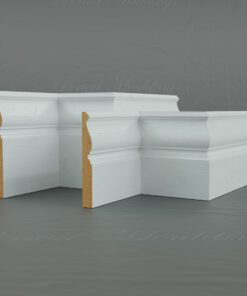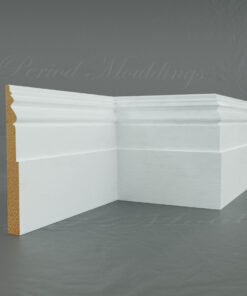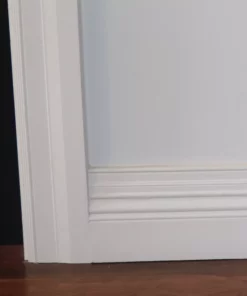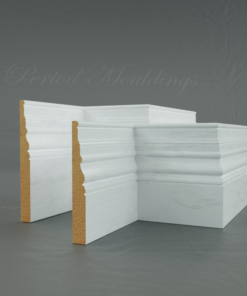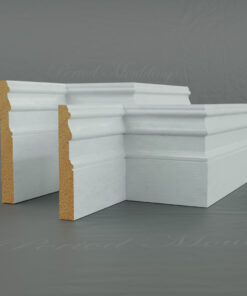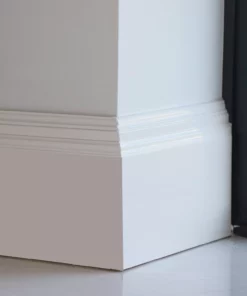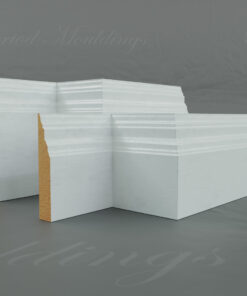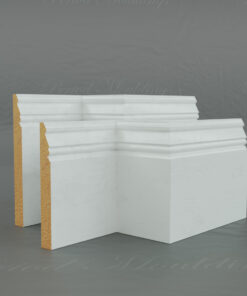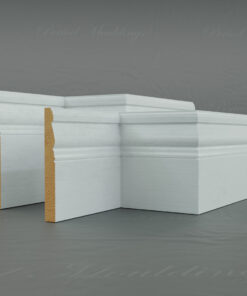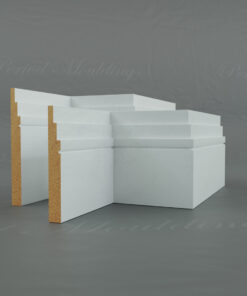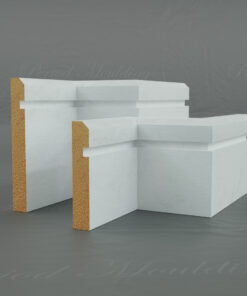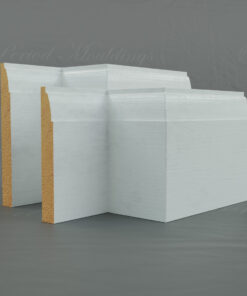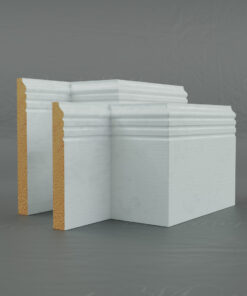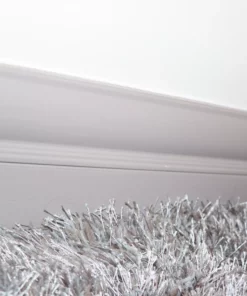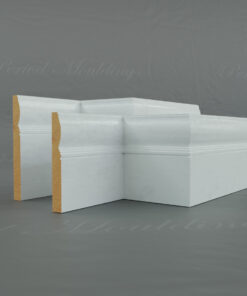Skirting boards are an architectural design necessity in the home, but many people don’t really know why. They can be seen as a pretty forgettable feature, but you would soon notice if they weren’t there and also, if you don’t choose your skirting boards wisely your mistakes can become a very visible and very constant reminder.
Contents
- What is the purpose of a skirting board?
- The different factors to consider when choosing your skirting boards
- What style of skirting is right for you?
- Choose your colour design carefully
- Materials need to suit the nature of your home
- Think about how you want to finish the skirting board
- Combining practicality, budgets and aesthetics
What is the purpose of a skirting board?
When considering skirting boards, it is perhaps worth reminding ourselves what their actual purpose is. Skirting boards do actually carry out a series of important functions, albeit many people see them as mere decoration. Traditionally, a skirting board was fitted to hide the junction between the floor and a plastered wall. This often developed cracks or rough edges, and the skirting board was a neat way to cover this up. It also helps to cover rough carpet ends in the same manner.
As a functional feature, a skirting board also acts to prevent the spread of drafts that can come through cracks in the bottom of a wall, and can also hide wires for electrical equipment. Essentially, however, a skirting board’s main purpose in a home now, is to provide a barrier to protect your wall and to take the brunt of daily activity in the house involving the kids, pets, vacuum cleaners and general traffic. A skirting board also provides an aesthetic completeness, and while some modern homes may not need them in terms of functionality, it sometimes looks odd when they are not there.
Georgian Skirting Boards
Exclusively From Period Mouldings
The different factors to consider when choosing your skirting boards
It is true that there are more influential features in the home in terms of getting the style of your internal design wrong, but skirting boards are definitely a factor in combining a number of features successfully, and they frequently act as a conduit to blending colour and style themes between rooms, to ensure the home is consistent and pleasing-on-the-eye.
Factors that you need to consider, therefore, are the style of the skirting board, the colours you choose, the material you opt for and the finish on the skirting board. All these combine to provide the perfect decorative completion to a room or a series of rooms, and therefore, it is important that you consider them all together and not in isolation.
What style of skirting is right for you?
There are some distinctive and quite unusual skirting board styles that are used in contemporary homes, such as recessed skirting and shadow gaps. These require considerable pre-planning, even when building the home, and therefore aren’t really conducive with the kind of discussion we are holding here, i.e. when looking at renovating a property or carrying out some basic home improvements. Therefore, we are faced with a straight choice between contemporary skirting boards and period skirting boards.
Of course, in modern homes a contemporary skirting board – often plain, minimalist and without intricate detail – will work, but it is possible that period skirting will too, if you blend in colour and furniture to suitably complement it. However, this does not really work the other way around, i.e. a contemporary skirting will not work in a period home where there are also dado rails or door and wall architrave. As with anything in the home, it is about getting the balance right. Georgian and Victorian style homes usually have quite tall and airy rooms, sometimes up to 3 metres high or more, while Edwardian homes are not quite as spacious, and rooms in contemporary homes are smaller still, averaging around 2.4 metres tall, or less. Whatever the style of your home is, however, the key factor is to ensure your skirtings are in proportion to the room size. You don’t want high skirtings in a short room, for example, and short skirtings will look somewhat lost and unnecessary in a tall room.
Whatever period of traditional or contemporary skirting you opt for, you need to be consistent in your choice. You are unlikely to get away with mixing and matching periods in different rooms, or in adjacent corridors, and definitely not in the same room. In this sense, you need to consider architrave, coving and dado rails too. Different period skirting can be very distinctive in terms of the curves, ridges and mouldings, so it is very difficult, and certainly not recommended, to put two styles together.
Victorian Skirting Boards
Exclusively From Period Mouldings
Choose your colour design carefully
Colour schemes are a big factor in getting a room right, or enabling a series of rooms and corridors to blend together. It is common to use skirting boards and architrave as a means of creating contrast, but you can also use them to create some subtle variation. Both can work, depending on the style of your home and what other furniture styles you have.
Many people opt for white walls and coloured skirtings. And in that sense, any colours will work as long as they complement the rest of the room and provide a ‘pleasing’ overall look. With this in mind, coloured skirtings against white walls frame a room very well and offer plenty of scope for wall decoration too. Having white skirting and coloured walls also works well, but is easier to get wrong, and having white skirtings will undoubtedly draw attention to them, so you need to ensure they have a good finish, because this will be detectable.
This sense of contrast can be toned down a little by choosing walls and skirting that have a more subtle variation, i.e. light grey skirting with a darker grey on the walls, or vice versa. But the other end of the spectrum is to have walls and skirting of the same colour. This is a more contemporary solution, and can be a strong statement that also provides a more spacious feel to a room.
Materials need to suit the nature of your home
It would be a mistake to ignore the importance of the material you choose for your skirting boards, as this can be a big factor in how they look, how easy they are to fit and how long they will last. MDF is widely used in modern homes, but can’t be machined or formed in the same way that natural wood can, and therefore can’t be applied to period styles of skirting. That’s fine if you have a modern home and want contemporary skirting, but it is a limiting factor.
MDF is also cheap and affordable, so is great if you are on a budget, but it can be susceptible to warping, chips and cracks, so you may find you need to replace it. Also, if you are spending money on a renovation or quality home improvements, sometimes it is worth spending a little bit extra on the qualities that natural wood offers.
Wooden skirting such as oak, pine, tulipwood or sapele, is durable and adaptable to many different styles. Most natural wood types are easy to machine and are also versatile in terms of the type of finish that can be applied, i.e. they will look great sanded down, or oiled, or varnished or painted. You can’t beat the natural look of a hard or softwood, however, and that is something that MDF simply can’t replicate.
Edwardian Skirting Boards
Exclusively From Period Mouldings
Think about how you want to finish the skirting board
There are a number of ways you can finish your skirting boards, and much of this is dependent on what materials you choose and the style of your room. Leaving natural wood looking natural, is perhaps not the wisest choice. It can look a little raw and of course is open to damage and moisture ingress. You can enhance or restore the natural look of wood with oils and varnish, which creates a more striking appeal and of course, adds some longevity to your skirting boards. Most natural woods can be sanded down easily and the resulting surface will take most finishes, even paint. The same can’t be said for MDF, which can be painted but will never give you a natural wood effect and can’t be sanded to then apply varnish, as the surface will become rough and unworkable. Therefore, MDF is only suitable for a contemporary skirting that you want to paint, and in that sense will leave you with a smooth finish that is very easy to apply.
In terms of painting natural wood skirting, you can opt for a gloss finish, which provides a nice lustre and contributes to the skirting becoming a striking feature in the home, or you can apply a matt or satin finish that tones this down a little. Undoubtedly, natural wood skirting offers you more versatility in terms of design detail and how you want the room or series of rooms to look.
Combining practicality, budgets and aesthetics
In summary, when choosing your skirting boards you need to consider practical materials to reflect the nature and function of your rooms, you need to consider longevity and how often you want to replace your skirtings, and you need to consider how they look adjacent to other features of the home. It is quite straightforward to swap skirting board styles like-for-like, but this doesn’t mean you can’t change the style, even from one period to another. You just need to consider other features such as architrave and dado rails, and hence, invest in a complete makeover.
Perhaps the most important factor is consistency, because this ties practicality, longevity and aesthetics together. Skirtings help rooms flow from one to another, and in corridors acts as an important means of using interior design detail to make a house work. So don’t underestimate the importance of skirting boards and don’t take any half measures when considering renovation or replacement. You might be of the opinion that skirting boards are an inconsequential item in the home, but get them wrong and you will quickly revise that opinion.
Contemporary Skirting Boards
Exclusively From Period Mouldings



